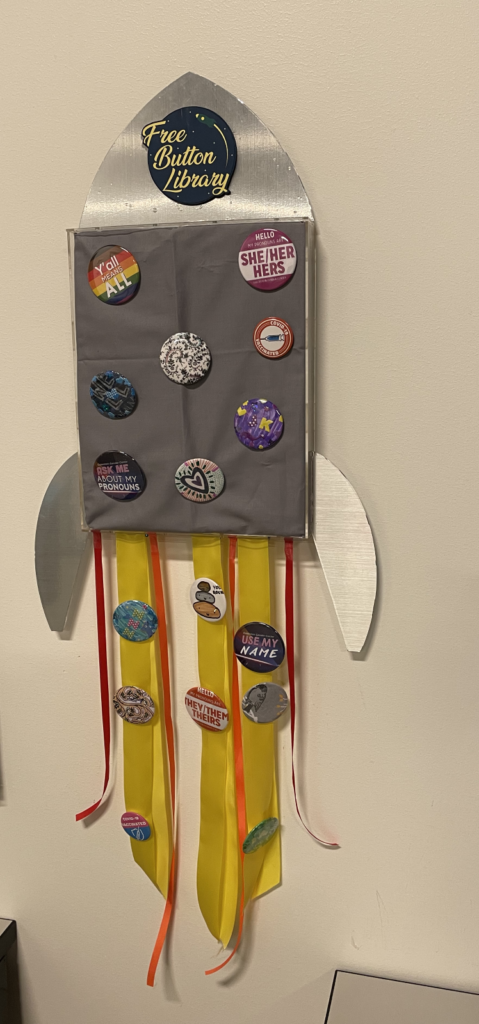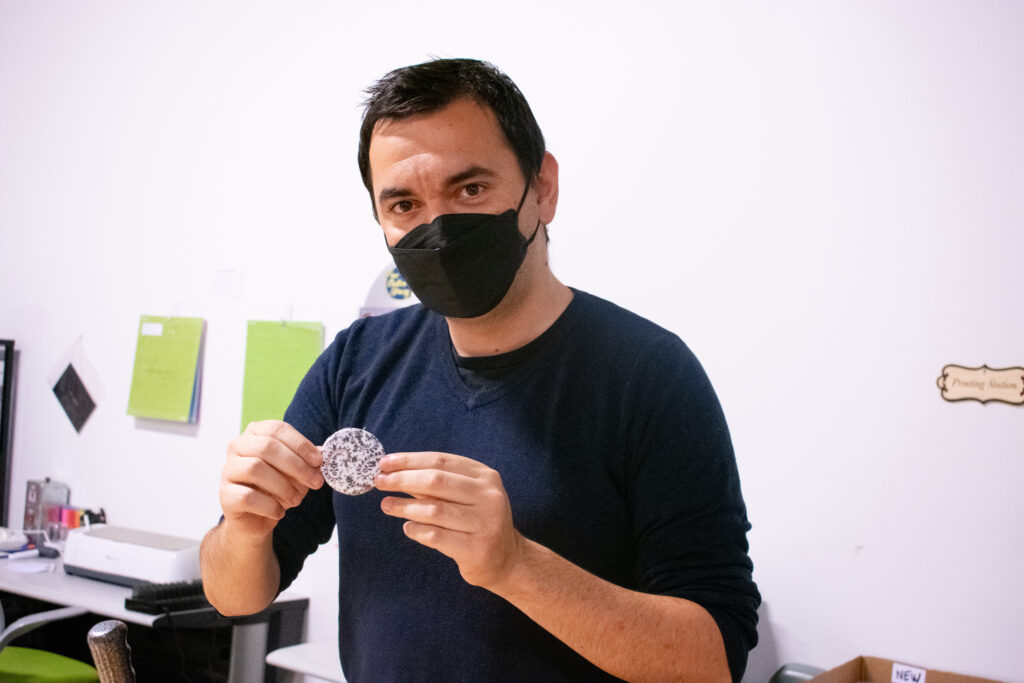Button Making is Political! by Fiona Haborak
In Spring 2022 at the AIGA Gala within ATEC, Fashioning Circuits hosted a button-making activity. Weaving together the connective threads of buttons as protest memorabilia, Fashioning Circuits chose to honor Earth Day. Aligned with the AIGA Gala’s celestial theme, the Free Button Library resembles a rocket taking flight and the lab was decorated to honor this occasion. ATEC student Yvonne Yu designed the library. Once buttons were forged, they would be secured to the fabric surface of the library which operates as a spatial site.

A slideshow displayed buttons from various archival sites such as the Harvard Library HOLLIS Images catalog, National Museum of American History, Busy Beaver Button Museum, and Archive.org. Those buttons on display allows for speculation as to how these pieces were pulled and salvaged from cultural spaces (Cvetkovich 9).

Lab members guided students through the act of making buttons. Participants designed and decorated a circular piece of paper before placing the button into the press. Invoking the DIY (do-it-yourself) ethos, participants were invited to make two buttons: one to take home and one to leave behind in the Free Button Library. As a self-made process, the DIY element signifies not only the intimacy of the making process, but also opposes capitalistic models for consumerism in terms of fast fashion. Furthermore, buttons are often disregarded as a piece of memorabilia or a prized possession. We acknowledge the importance of documentation and preservation with respect to the button, both as a physical object and as an ephemeral concept. Buttons speak loudly and proudly.
To quote Norda Majekodunmi, “Cheaply made, [buttons] are easily discarded after use and, thus, are rarely considered for collection and preservation. However, despite their transient nature, political buttons possess intrinsic value as physical manifestations of political activism and, therefore, are worthy of collecting, and study” (756).
As a piece of ephemera, buttons “remain after a performance, a kind of evidence of what has transpired but certainly not the thing itself. It does not rest on epistemological foundations but is instead interested in following traces, glimmers, residues, and specks of things. …[Ephemera] is a mode of proofing and producing arguments often worked by minoritarian culture and criticism makers.” (Muñoz 10).
Overall, we acknowledge how buttons communicate a socio-historical history enveloped in protest. In “Eminently Visible: The Role of T-Shirts in Gay and Lesbian Public Advocacy and Community Building,” Joel Penney remarks upon how t-shirts and buttons convey coded messages whilst simultaneously serving as a visible marker related to protest and queer identity (Penney 289). The activity emulates how queer publics used buttons as a sign of political protest; in addition, the Bay Area in San Francisco’s historical experience of political activity in the 1970s and 1980s demonstrated a rise in feminist movement (bayarealesbianarchives.org). While this does not communicate the full history of buttons, we learn to embrace the critical narratives imprinted on each and every one.
Testimonials
“During the button making workshop, organized in the AIGA Gala event, participants had shown a lot of enthusiasm and excitement to be able to make buttons as a result of their creative and experimental engagement in the process of making buttons that also displays the designs they create during the workshop.” – Atanur Andic

[Photo Credit: Viet Khue Vu (@vivukhue)]
“Participants in the Button-Making Workshop, facilitated by Fashioning Circuits at the AIGA Gala, exuded an excitable, passionate energy that was deeply felt by many involved; the act of creating these buttons was a process that united people in the act of making and sharing the results of that making” – Fiona Haborak
Works Cited
Bay Area Lesbian Archives. “About | Bay Area Lesbian Archives.” Bay Area Lesbian Archives, Bay Area Lesbian Archives, 2022, https://www.bayarealesbianarchives.org/about.
Cvetkovich, Ann. An Archive of Feelings: Trauma, Sexuality, and Lesbian Public Cultures. Duke University Press, 2003.
Cvetkovich, Ann. “In the Archives of Lesbian Feelings: Documentary and Popular Culture.” Camera Obscura, vol. 17, no. 49, 2002, pp. 107-147.
Majekodunmi, Norda. “Talking Pieces: Political Buttons and Narratives of Equal Rights Activism in Canada.” Journal of Black Studies, vol. 47, no. 7 (2016): 753–722. https://doi.org/10.1177/0021934716649644.
Muñoz, José Esteban. “Ephemera as Evidence: Introductory Notes to Queer Acts.” Women & Performance: A Journal of Feminist Theory, vol. 8, no. 2, 1996, pp. 5-16, doi:10.1080/07407709608571228.
Penney, Joel. “Eminently Visible: The Role of T-Shirts in Gay and Lesbian Public Advocacy and Community Building.” Popular Communication, vol. 11, no. 4, 2013, 289–302, doi:10.1080/15405702.2013.838251.
